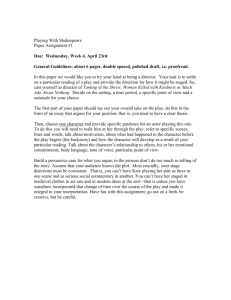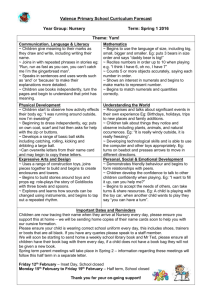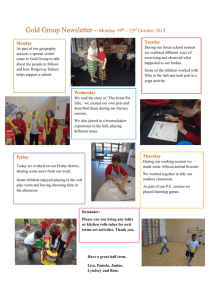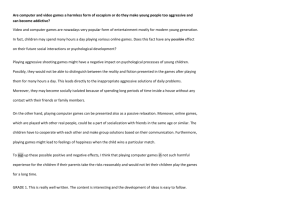Playing as a leading child`s activity
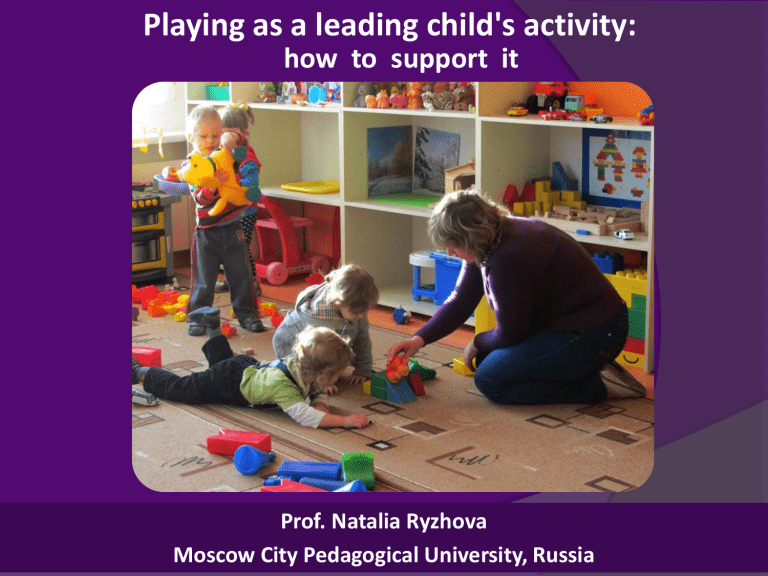
Playing as a leading child's activity:
how to support it
Prof. Natalia Ryzhova
Moscow City Pedagogical University, Russia
Playing is an inherent part not only in children's lives, but in lives of the whole humanity
Many modern games have their roots in our past
At the same time many pedagogues notice that modern children don’t play enough.
There are various reasons that contribute to this tendency
Playing: opinions of scientists and children
“Playing is the main work for me”
F. Frobel:
Playing is not a childish whim, it is the summit of a child's development
Dmitriy, 6 years old:
“Kids need toys when
they are bored.
A kid would take
a toy and have fun”
J. Piaget
Classification of games: games with exercises, symbolic games, games with rules
Playing: opinions of scientists and children
L. Vygotsky:
Game is a source of development, it creates a zone of proximal development. Playing is really a distinctive feature of preschool age
“ The more you play with toys, the more you learn different things”
(Maria, 7 years old)
OMEP resolution “World declaration about the right and the joy to learn through play”: «...we must defend the UN Convention on the Rights of the Child, especially the right of children to play as well as ensuring their wellbeing in all countries and in educational programs». Gothenburg, 2010
D. Elkonin: Playing is a leading child's activity
Types of playing: initiated by children themselves, started by adults, and folk games, which have their origin in historical traditions of an ethnic group
(by S. Novoselova)
Classification of games
Free playing
Role games
Games-experiments
Didactic games
Development of playing reaches its summit in free role playing games, that belong to the first class of games in this classification
Method 1: special research
The research has been conducted starting from 2007 to 2012 in eight
Moscow preschool institutions.
The research was aimed at studying support of children’s initiative and independent activity, including playing
Several issues were studied: how kindergartens implement children’s right to play; what pedagogues do to ensure this right; to what extent children are able to play independently;
how the kindergarten’s developing surrounding contributes to this process; how playing is integrated with the other types of children’s activities ; what can be done to secure children's natural right to play
in preschool institutions and in families; how pedagogues can support free playing
Method 1: special research
The main questions set by the research:
What is the position of playing (in particular, free playing) in modern kindergarten; whether preschool children have an opportunity to start and follow playing on their own initiative;
What are the outlooks of pedagogues and parents on the role of playing in children's life; what obstacles there are, impeding playing in kindergarten; what can be done to secure children's natural right to play in preschool institutions and in families; how pedagogues can support free playing
The tasks of the research included, in particular: studying developing environment in kindergartens, considering conditions for playing; analyzing daily schedule of preschool institutions (amount of time available for playing); discovering pedagogues' and parents' attitudes to child's playing; analysis of educational programs in a kindergarten; studying availability of support for children's initiative on the part of kindergarten pedagogues.
Method 1: special research
Learning environment
Additional materials
Indicators
Method 1: special research
Diversity of toys
Construction zone
The lab
Method 1: special research
Pedagogues, psychologists and the scientific advisor have observed children in playing, questioned them according to the specially designed questionnaires, had free conversations with them.
Children were observed both inside the kindergarten building and outdoors
The research, its progress and preliminary results have been constantly discussed and given further impulse at the pedagogical councils, conferences and workshops, being published on the City Educational
Department website. Parents were able to get information from the websites of preschool institutions, teacher-parent meetings, and other events, arranged by kindergartens
Method 2:
I
nterviews of children & adults
In 2012-2013 three types of questionnaires were created to reveal the attitudes of pedagogues and parents to playing
The questions included in this form aimed at founding out the following: what the child's attitude towards playing is; whether she or he thinks that there's enough of playing in kindergarten and at home; whether she or he has toys that are most loved; whether she or he knows about the games played by her or his parents and pedagogues in their childhood; whom she or he likes to play with most of all; whether he or she plays computer games what do you think, do adults like playing? why don't they play as often as children do?
Method 2: Interviews of children & adults
The questions for parents are aimed at researching their attitude towards children's playing: whether the child plays at home; what her or his favorite toys are; whether family members play with the child (at home, on vacation, on weekends; if yes, how often they do it); whether the child starts playing on he/ her own or is he/she waiting help from the family members to begin playing
Compared to the questionnaire for children, many questions in this form were redundant to some extent
1960
Grandmothers' childhood: their favourite stuffed toys
Two generation gap 50 years
2010
Granddaughters' childhood: their favourite stuffed toys plus their favourite tablet PC
Method 2: interviews of children & adults
Pedagogues were asked to tell the following: what their opinion is on the amount and quality of toys in the kindergarten; their opinion on the role of playing in the life of the kindergarten; whether they organize games themselves and support children's initiative; whether they initiate family games and folk games; whether they play their childhood games with children; what the problems are that prevent creation of environment for free playing for children
The questionnaire included a number of questions, matching the ones in the first two forms, so that they could be compared for analysis
Method 3: Analysis of the results of competition for pedagogies
Method 4: Analysis of family experience
Competition "Russian
Pedagogue of the Year: attitudes of pedagogues to children's playing activities (discussion)
Author's personal experience of support for playing
within the family
(observations, experiments)
Time for playing: some documents
Until recently daily schedules in kindergartens included lessons of math, speech development, PE, studies of the world around, etc.
New Federal requirements to educational programs, more flexible scheduled educational activities children's initiative and independent playing should be supported
Pedagogue's support for playing: parents
Many parents don't regard playing as a serious matter.
Playing, in the opinion of many parents, has nothing to do with preparing for school
Parents:
“The child uses every minute for playing”
“There's no time for playing, after kindergarten our child goes to the dances, studies
English”
Pedagogue's support for playing: parents
At the same time many parents mention that modern children spend too much time playing computer games, that have negative influence on preschool children's health; that they should play active games together with children more (22%)
Only 3% of children play
with traditional or
handmade toys
Pedagogue's support for playing: teachers
Despite the fact that playing initiative comes from children, pedagogue's support is crucial for them. To give such support means to have special pedagogical intuition, so as not to make it intrusive or commanding
It was found out that in order to develop a role-playing game a pedagogue can offer an idea to children, who accept it and develop it in their game
Pieter Brueghel, 1601
Traditional playing, 1960
Children's games nowadays: changes
Today the playing changes more rapidly than in earlier times. Modern children, especially in urbanized environments, rarely play in the streets. Even in the previous century games still fulfilled its function: they transferred values across generations, playing was a part of children's socialization. Significant differences between generations had been found in their playing activity.
Child’s response: “I don't know what games my parents played, I haven't seen them as little kids”.
Traditional playing, 2012
Children's games nowadays: construction
88% of parents mentioned construction kits as their home toys, and construction as the favorite activity of their child. Pedagogues also state that modern children enjoy construction, but after it had been completed, they often loose all interest in the structure and can't use it in a role-playing game
Combination of construction and free playing develop imagination and creativity: the city for toys was built according to child’s idea from different materials
Children's games nowadays: construction
Construction for free playing
Construction for building
When toys of different kinds, proxy objects, or even details from other construction kits are added to ready constrictions, children are encouraged to play
Children's games nowadays: traditional priorities
Girls traditionally express more liking for dolls, especially princesses and Winx dolls, while boys are more interested in car models
Children's games nowadays: gender aspects
However, there are certain changes: boys more often play at family with girls, while girls play with toy army vehicles
A toy horse for boys and a toy horse for girls
Children's games nowadays: uniform standard toys
In different countries children play the same toys manufactured by the same companies. In this regard it is interesting and challenging to compare free role games played by preschool children in various parts of the world in a similar developing environment
Outfit for role-playing usually includes standard “at the barber's”, “at the hospital”,
“at the shop”, and “family” sets
Children's games nowadays: everything ready-made for playing
About 40 or 60 years ago preschool children used a lot of accidental objects to make an imaginary shop: they made a cash desk of pieces of plywood, found some substitute for money (small leaves often served well), things representing goods for sale, and so on
This shop has been created by children's imagination
Modern children, having everything ready for them, don't experience this need for collaboration and investigation – they are left with the task of distributing roles and acting out a scenario that is determined mostly by the ready-made objects they possess. This situation isn't favorable for stimulating creativity and imagination
Children's games nowadays:
everything ready for playing
Eggs from felt
(with mom’s help)
Fruits from plasticine
(with teacher)
Knitting vegetables
(with granny)
For free playing it’s important to add different handmade things to plastic ones
Potato from foam plastic (with grandpa)
When children do such things with adults, they join other types of children's activities and learn cooperation
Beet from felt
(with teacher)
Children's games nowadays: proxy toys
Many kindergartens don’t have much materials that a child could use as proxy toys.
Nevertheless availability of proxy toys is essential for support of playing, imagination, creativity and sensory development of children (all artificial plastic toys have similarly smooth surface, unlike any objects found in nature)
Proxy toys: cap as a plate, colored tissue as a cake for a doll
Weight can be measured with readymade weight pieces...
… but if you use your imagination, also with pine cones, shells, and pebbles
Children's games nowadays: a number of toys
99% of children said that they have a lot of toys in their kindergarten and at home
Problem: numerous dolls -- positive or negative aspects ?
Granddaughter: 25 dolls of one type
1960-s
The author: 3-5 dolls
Children's games nowadays: playing with models
Different kinds of models instigate roleplaying too. That's why, while making the research, children, together with their pedagogues and parents, had created models of diverse natural landscapes, models of their own city, or kindergarten territory, that were eagerly used in playing
A ship model was made in the kindergarten from waste material (used wrapping, and similar stuff)
Model of the kindergarten territory was made in family from waste material
Children's games nowadays: traditional games
Children show increased interest towards folk games after they have familiarized themselves with everyday household items used by elder generation
Folklore rooms stimulates children's interest in folk playing, they also help a pedagogue to get children acquainted with cultures of different nationalities.
In the course of the research group classrooms in kindergartens had been embellished with mini-museums of a folk puppet, or a folk toy
How can playing be supported: opportunities
Children should have an opportunity to play both in kindergartens and at home.
To ensure this opportunity they must have enough time, space, various toys, proxy objects, support on the part of adults, communication with their peers.
It is necessary to keep a balance between math, foreign languages and other components of preschool education on the one side, and playing on the other. Pedagogues should find ways to include games into the educational process.
Developing environment in class rooms and on the kindergarten territory should include a variety of toys, playing modules, constriction kits, proxy toys, natural and waste material, accessories for different games, mini-labs, old used things, models, hand-made toys etc.
How can playing be supported: training for teachers & students
Training of pedagogues should include playing, too, so that they could themselves realize and feel the importance of playing. For example, when pedagogues start playing children's games, they encounter the same problems as children do: need to negotiate, to cooperate, to consider opinions of others etc.
Students create toys from waste material and thing of the ways to play with them
ESD through playing
Sharing interesting and efficient experience is crucial for pedagogues
How can playing be supported: kindergartens & families
It is very important for children to be treated as equal, to be heard.
Kindergartens can unite families for playing, organize family competitions, learn to play different games with children and adults, invite parents
to visit kindergarten so that they could watch their children play
In order to bridge this communication gap, families can join their efforts.
Modern children are thrilled by computer games and films, the characters of which they want to imitate. Parents and pedagogues can offer preschool children such TV programs and films that are suitable for their age (interviews have shown that some children watch TV series for adults) and use their favorite characters for role games and active playing, make new stories about them, build houses and towns for them.
Today many families have only one child, grandparents don't often contact their grandchildren
Thus, the main concepts for support of children's right to playing can be stated as following: change of attitudes towards playing in the society as a whole
– acknowledgement of childhood as a value in itself and playing as its major characteristic; change of attitude to playing on the part of pedagogues; creation of suitable developing environment; partnership between adults and children; support for children's free playing initiative; interaction between kindergartens and families; respect towards children's playing in general
